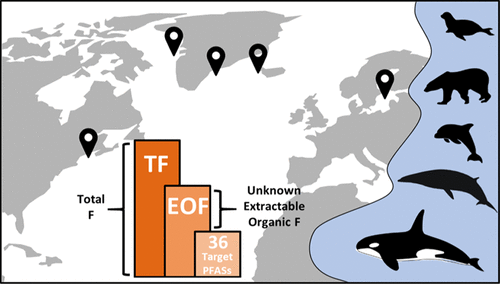当前位置:
X-MOL 学术
›
Environ. Sci. Technol.
›
论文详情
Our official English website, www.x-mol.net, welcomes your
feedback! (Note: you will need to create a separate account there.)
Fluorine Mass Balance and Suspect Screening in Marine Mammals from the Northern Hemisphere.
Environmental Science & Technology ( IF 10.8 ) Pub Date : 2020-03-24 , DOI: 10.1021/acs.est.9b06773 Kyra M Spaan 1 , Carmen van Noordenburg 1 , Merle M Plassmann 1 , Lara Schultes 1 , Susan Shaw 2 , Michelle Berger 2 , Mads Peter Heide-Jørgensen 3 , Aqqalu Rosing-Asvid 3 , Sandra M Granquist 4, 5 , Rune Dietz 6 , Christian Sonne 6 , Frank Rigét 6 , Anna Roos 3, 7 , Jonathan P Benskin 1
Environmental Science & Technology ( IF 10.8 ) Pub Date : 2020-03-24 , DOI: 10.1021/acs.est.9b06773 Kyra M Spaan 1 , Carmen van Noordenburg 1 , Merle M Plassmann 1 , Lara Schultes 1 , Susan Shaw 2 , Michelle Berger 2 , Mads Peter Heide-Jørgensen 3 , Aqqalu Rosing-Asvid 3 , Sandra M Granquist 4, 5 , Rune Dietz 6 , Christian Sonne 6 , Frank Rigét 6 , Anna Roos 3, 7 , Jonathan P Benskin 1
Affiliation

|
There is increasing evidence that the ∼20 routinely monitored perfluoroalkyl and polyfluoroalkyl substances (PFASs) account for only a fraction of extractable organofluorine (EOF) occurring in the environment. To assess whether PFAS exposure is being underestimated in marine mammals from the Northern Hemisphere, we performed a fluorine mass balance on liver tissues from 11 different species using a combination of targeted PFAS analysis, EOF and total fluorine determination, and suspect screening. Samples were obtained from the east coast United States (US), west and east coast of Greenland, Iceland, and Sweden from 2000 to 2017. Of the 36 target PFASs, perfluorooctane sulfonate (PFOS) dominated in all but one Icelandic and three US samples, where the 7:3 fluorotelomer carboxylic acid (7:3 FTCA) was prevalent. This is the first report of 7:3 FTCA in polar bears (∼1000 ng/g, ww) and cetaceans (<6–190 ng/g, ww). In 18 out of 25 samples, EOF was not significantly greater than fluorine concentrations derived from sum target PFASs. For the remaining 7 samples (mostly from the US east coast), 30–75% of the EOF was unidentified. Suspect screening revealed an additional 37 PFASs (not included in the targeted analysis) bringing the total to 63 detected PFASs from 12 different classes. Overall, these results highlight the importance of a multiplatform approach for accurately characterizing PFAS exposure in marine mammals.
中文翻译:

北半球海洋哺乳动物中的氟质量平衡和可疑筛查。
越来越多的证据表明,约 20 种常规监测的全氟烷基和多氟烷基物质 (PFAS) 仅占环境中可萃取有机氟 (EOF) 的一小部分。为了评估北半球海洋哺乳动物的 PFAS 暴露是否被低估,我们结合针对性 PFAS 分析、EOF 和总氟测定以及可疑物筛选,对 11 个不同物种的肝组织进行了氟质量平衡。 2000 年至 2017 年间,从美国东海岸、格陵兰岛西海岸和东海岸、冰岛和瑞典采集了样品。在 36 种目标 PFAS 中,除一份冰岛样本和三份美国样本外,全氟辛烷磺酸 (PFOS) 在所有样本中均占主导地位。 ,其中 7:3 氟调聚物羧酸 (7:3 FTCA) 很普遍。这是北极熊 (∼1000 ng/g, ww) 和鲸类 (<6–190 ng/g, ww) 中 7:3 FTCA 的首次报告。在 25 个样品中的 18 个中,EOF 并未显着高于目标 PFAS 总和中的氟浓度。对于其余 7 个样本(主要来自美国东海岸),30-75% 的 EOF 未识别。可疑筛查发现另外 37 种 PFAS(未包含在目标分析中),使检测到的 PFAS 总数达到 63 种,来自 12 个不同类别。总体而言,这些结果凸显了多平台方法对于准确表征海洋哺乳动物中 PFAS 暴露的重要性。
更新日期:2020-03-24
中文翻译:

北半球海洋哺乳动物中的氟质量平衡和可疑筛查。
越来越多的证据表明,约 20 种常规监测的全氟烷基和多氟烷基物质 (PFAS) 仅占环境中可萃取有机氟 (EOF) 的一小部分。为了评估北半球海洋哺乳动物的 PFAS 暴露是否被低估,我们结合针对性 PFAS 分析、EOF 和总氟测定以及可疑物筛选,对 11 个不同物种的肝组织进行了氟质量平衡。 2000 年至 2017 年间,从美国东海岸、格陵兰岛西海岸和东海岸、冰岛和瑞典采集了样品。在 36 种目标 PFAS 中,除一份冰岛样本和三份美国样本外,全氟辛烷磺酸 (PFOS) 在所有样本中均占主导地位。 ,其中 7:3 氟调聚物羧酸 (7:3 FTCA) 很普遍。这是北极熊 (∼1000 ng/g, ww) 和鲸类 (<6–190 ng/g, ww) 中 7:3 FTCA 的首次报告。在 25 个样品中的 18 个中,EOF 并未显着高于目标 PFAS 总和中的氟浓度。对于其余 7 个样本(主要来自美国东海岸),30-75% 的 EOF 未识别。可疑筛查发现另外 37 种 PFAS(未包含在目标分析中),使检测到的 PFAS 总数达到 63 种,来自 12 个不同类别。总体而言,这些结果凸显了多平台方法对于准确表征海洋哺乳动物中 PFAS 暴露的重要性。











































 京公网安备 11010802027423号
京公网安备 11010802027423号